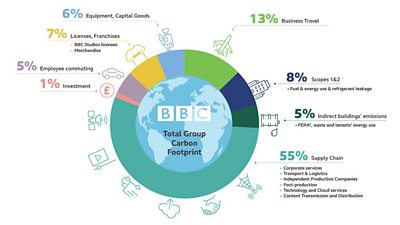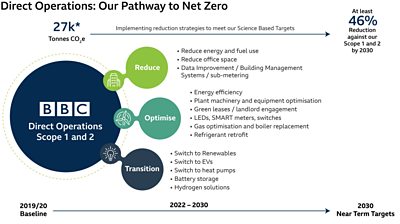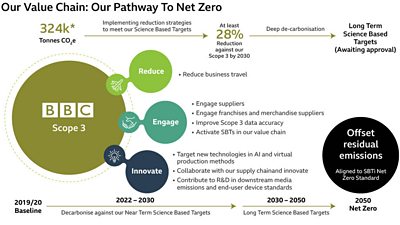The ±«Óãtv is committed to reducing greenhouse gas (GHG) emissions from our direct operations (Scopes 1&2) by 46% and from our value chain (Scope 3) by 28%, both by Financial Year (FY) 2030/31 from a FY 2019/20 baseline.
These Short-Term Net Zero emissions targets were approved by the (SBTi) in 2021 and have since been assured by a number of external partners. They are challenging goals, but we believe that they are the right approach now.
To meet the SBTi standard, our Long-Term Net Zero emission reduction targets to reduce all emissions by at least 90% by 2050 were also approved by the SBTi in August 2024.
This is a key milestone on our journey to becoming a ‘True Net Zero’ organisation by 2050, which is a credible approach and is the same timeline the UK Government is working to. Our approach is aligned to the latest climate science and is focused on eliminating our emissions at source and permanently which is also referred to as ‘deep decarbonisation’.
This will be a huge collective effort. It won’t be easy, but we must act, and act now, to reduce our environmental impact.
The ±«Óãtv’s Carbon Footprint
The ±«Óãtv Group’s total greenhouse gas emissions for FY 2019/20 is our baseline against which we measure our progress in reaching our net zero targets. We follow leading practice to continually improve our GHG emission data sets and the calculations used for our emissions reporting. We make adjustments to our baseline emissions data when they are significantly impacted by structural changes to the business, if we update our calculation methodology or if we discover errors.
During 2023/24, we recalculated our Scope 3 baseline applying Exiobase emissions factors to spend and revenue-based input data, as these factors are better aligned to our business type and global operations. We have also recalculated our Scopes 1&2 baseline data. Read more about the basis of this reporting under ±«Óãtv's Greenhouse Gas Footprint calculations here. We publicly restate revised baseline and historical GHG emissions figures in the (see Environmental Sustainability on pp.67-71)
The FY 2019/20 emissions baseline proportions are shown below.

Emission Scope Boundaries
In line with greenhouse gas accounting, the emissions in the chart above are grouped into three main ‘Scopes’ 1, 2 and 3. The diagram below shows what contributes to each of those Scopes for the ±«Óãtv.

Scope 1 Fossil Fuels - Direct emissions from the fuel (gas, diesel, oil, petrol) which the ±«Óãtv buys and burns in its buildings, operations and fleet and the fugitive emissions from refrigerant gases.
Scope 2 Electricity - Indirect emissions from the electricity that the ±«Óãtv buys to use in its buildings and operations as well as steam, heating and cooling processes that we purchase for our own use.
Scope 3 Value Chain - Indirect emissions from our suppliers including independent production and distribution of our content, our own business travel, franchises and capital goods. Upstream emissions are from activities that happen before our production processes and downstream emissions are from what we do with our products after production, including audiences watching and listening to our content (use of sold products), disposal of our products and financial investments.
Emissions from upstream leased assets are from buildings where the ±«Óãtv is a tenant; those from downstream leased assets are from buildings where the ±«Óãtv is the landlord and we lease the asset to another organisation.
Emissions from upstream fuel and energy related activities happen during the extraction, production and transport of the fuel and electricity that the ±«Óãtv buys before it reaches us to be used.
Read more detailed definitions of these greenhouse gas accounting terms .
Deep decarbonisation: Scopes 1 and 2
Scope 1&2 emissions make up 6% and Scope 3 contribute 94% of our overall total ±«Óãtv Group GHG emissions.
Our near-term Science Based Targets commit us to reducing our Scope 1&2 emissions by 46% by 2030 and our Scope 3 emissions by 28% by 2030.
Our strategy is for deep decarbonisation, drastically reducing the carbon emissions that we generate and targeting and eliminating our fossil fuel usage across the organisation.
The diagrams below outline some of the mechanisms for achieving such deep decabonisation.

To reach our target of a reduction in scopes 1 and 2 greenhouse gas emissions we will reduce our direct operational emissions by cutting back on energy and fuel use, by economising on office space, by improving our data and building management systems and upgrading our energy sub-metering.
We will optimise our direct operational emissions by improving energy efficiency, scaling up our building monitoring and evaluation, upgrading our heating and cooling systems and liaising with landlords to overhaul premises that we lease.
We will transition to low-carbon operations by switching to renewables, an electrically powered car fleet and operational vehicles, heat pumps for our buildings, better battery storage of energy and hydrogen power solutions for outside broadcasts (amongst other applications).
Deep decarbonisation: Scope 3

*updated April 2024 as part of continual improvement to our GHG data sets, as explained above.
We will reduce our value chain emissions by cutting back on unnecessary business travel.
We will engage with our suppliers, franchise holders and merchandise producers to discuss how they can use SBT’s to cut their own emissions. We will dig deeper into their carbon data to understand our value chain emissions better and improve transparency and accuracy of our scope 3 data.
We will innovate in our value chain by collaborating with suppliers to introduce new, carbon efficient broadcasting technologies and end-user device standards.
By working with suppliers and the rest of the industry, we believe we can help create a sector aligned with the science that has a clear pathway to cut its GHG emissions to Net Zero to prevent the worst effects of climate change.
We are asking our most important and valued suppliers to share their environmental performance data through a global non-profit specialized in environmental reporting. Please see our CDP FAQs document here.
We are pursuing deep decarbonisation to achieve our net zero goals as this is what the science is telling us we need to do. Our approach will be transparent while working collaboratively with our supply chain and industry partners to drive the change that’s needed.
